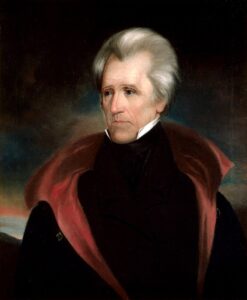 I’m not sure why it is that every president “needs” a pet. Nevertheless, it seems that it is expected, and the “first dog” seems to be the most common choice of pet. Dogs are the most commonly talked about pets in the White House…in recent years anyway. The fact is that ever since George Washington, there has been a myriad of different animals that earned the title of presidential pet or first pet. Some of the more manageable animals to come under the care of the president were cats, horses, donkeys, cows, goats, and hamsters. Oddly, there were also the more “unique” animals that lived in the White House too, including, and often only temporarily, bobcats, raccoons, lions, tigers, and bears, if you can believe it.
I’m not sure why it is that every president “needs” a pet. Nevertheless, it seems that it is expected, and the “first dog” seems to be the most common choice of pet. Dogs are the most commonly talked about pets in the White House…in recent years anyway. The fact is that ever since George Washington, there has been a myriad of different animals that earned the title of presidential pet or first pet. Some of the more manageable animals to come under the care of the president were cats, horses, donkeys, cows, goats, and hamsters. Oddly, there were also the more “unique” animals that lived in the White House too, including, and often only temporarily, bobcats, raccoons, lions, tigers, and bears, if you can believe it.
One of the more common kind of animals was the variety of birds that have worn the title pf presidential pet. Birds, such as turkeys, mockingbirds, parakeets, and several other species of parrot and songbird have been the companions of past presidents and their families. One of the presidents that had a bird was Andrew Jackson, the seventh president, who owned a variety of pets, among them, an African grey parrot named Poll that he had purchased for his wife, Rachel. Unfortunately, had very little influence on Poll, because she died of a heart attack not long after his election in 1828. Because of Rachel’s untimely death, and unlike other presidential parrots, Poll took on some of Jackson’s more unbecoming characteristics. To put it mildly, Andrew Jackson was 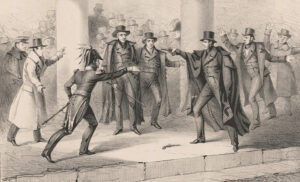 an exceptionally volatile individual who often disregarded formality. On the one hand, Jackson’s character helped him to actually survive an assassination attempt and to win the Battle of New Orleans. Both of these made him quite popular, even though the treaty that followed the battle, was almost pointless, and so the battle was viewed much the same. On the other hand, as both a general and later president, Jackson used every tool at his disposal to crush indigenous sovereignty. He really had no use for the Native Americans, or at least not for their rights as a sovereign nation. In fact, his actions both directly and indirectly caused the deaths of thousands of Native Americans.
an exceptionally volatile individual who often disregarded formality. On the one hand, Jackson’s character helped him to actually survive an assassination attempt and to win the Battle of New Orleans. Both of these made him quite popular, even though the treaty that followed the battle, was almost pointless, and so the battle was viewed much the same. On the other hand, as both a general and later president, Jackson used every tool at his disposal to crush indigenous sovereignty. He really had no use for the Native Americans, or at least not for their rights as a sovereign nation. In fact, his actions both directly and indirectly caused the deaths of thousands of Native Americans.
Nevertheless, where Poll was concerned, the loss of Rachel and Jacksons crude talk led to a number of problems later on. Poll was therefore almost constantly exposed to the already foul-mouthed and hot-tempered president. I don’t suppose all that matter very much to Jackson, who was obviously used to his own way of speaking, but on the day of Jackson’s funeral, it was decided by Jackson, that Poll was to be in attendance, 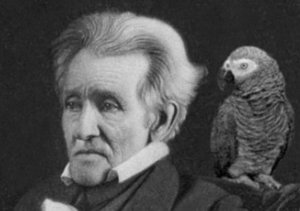 along with the grieving spectators. I can only imagine the guests, especially of that era, Jackson passed away on June 8, 1845, when after possibly being unnerved by the number of people, Poll proceeded to shock all of the guests when he began to exclaim all sorts of profanity and otherwise inappropriate language. According to witnesses, Poll’s outbursts were so disruptive that the bird had to be escorted away from the proceedings. Even after his departure, I’m sure that the prim and proper ladies and gentlemen had to take a moment to compose themselves before the funeral could continue. I guess it just goes to show that sometimes, more than just our children are listening to every word we say.
along with the grieving spectators. I can only imagine the guests, especially of that era, Jackson passed away on June 8, 1845, when after possibly being unnerved by the number of people, Poll proceeded to shock all of the guests when he began to exclaim all sorts of profanity and otherwise inappropriate language. According to witnesses, Poll’s outbursts were so disruptive that the bird had to be escorted away from the proceedings. Even after his departure, I’m sure that the prim and proper ladies and gentlemen had to take a moment to compose themselves before the funeral could continue. I guess it just goes to show that sometimes, more than just our children are listening to every word we say.

 My niece, Kellie Hadlock is one of those rare people who never seems to have a bad day. If she does, she certainly never shows it. She is always smiling and laughing. I remember my mom telling us that we shouldn’t frown because our face would get stuck like that. Well, Kellie’s face has certainly become stuck in a constant smile, and that is not a bad thing at all. Kellie shares her birthday with one of my favorite ancestors, my great aunt, Bertha Schumacher. I never met Aunt Bertha, but her journal has been a plethora of information on the Schumacher side of my family history for years now. Kellie isn’t a writer, nor is she specifically anything like Aunt Bertha, but they do share their special day…no charge for that tidbit…that was put in for free.
My niece, Kellie Hadlock is one of those rare people who never seems to have a bad day. If she does, she certainly never shows it. She is always smiling and laughing. I remember my mom telling us that we shouldn’t frown because our face would get stuck like that. Well, Kellie’s face has certainly become stuck in a constant smile, and that is not a bad thing at all. Kellie shares her birthday with one of my favorite ancestors, my great aunt, Bertha Schumacher. I never met Aunt Bertha, but her journal has been a plethora of information on the Schumacher side of my family history for years now. Kellie isn’t a writer, nor is she specifically anything like Aunt Bertha, but they do share their special day…no charge for that tidbit…that was put in for free.
Kellie’s sister, Jessi Sawdon tells me that Kellie is the fun aunt. Jessi lays claim to being the cool aunt, but every kid loves it more when Aunt Kellie is around. It’s easy to love Kellie, because she loves to laugh and loves life. Kellie loves singing and is one of the worship leaders at church. She and her dad, Chris Hadlock practice many songs at te house, while he accompanies her on the guitar. Her mom, Allyn loves those practice sessions. It’s 
 like having her own concert. Jessi’s daughter, Adelaide absolutely loves to sing like Aunt Kellie. As kids, Kellie’s older siblings, Jessi, Ryan Hadlock, and Lindsay Moore never missed an opportunity to tell Kellie to shut up, because she was always singing. Jessi has received a little payback these days, because now Adelaide is doing the same thing. The good news for Adelaide is that they don’t tell her to shut up. Jessi figures her mom felt the same way, you just can’t tell your sweet little girl not to sing…even if her siblings can. Kellie just does all the “Kellie things” and that makes her fun.
like having her own concert. Jessi’s daughter, Adelaide absolutely loves to sing like Aunt Kellie. As kids, Kellie’s older siblings, Jessi, Ryan Hadlock, and Lindsay Moore never missed an opportunity to tell Kellie to shut up, because she was always singing. Jessi has received a little payback these days, because now Adelaide is doing the same thing. The good news for Adelaide is that they don’t tell her to shut up. Jessi figures her mom felt the same way, you just can’t tell your sweet little girl not to sing…even if her siblings can. Kellie just does all the “Kellie things” and that makes her fun.
Kellie has become a knitting/crocheting extraordinaire. Jessi isn’t in to that stuff, so she isn’t sure she could tell the difference. Kellie learned a long time ago from her Meemaw (Ramona Hadlock), and seemed to like it, but she didn’t love it then, like she does now. These days, everyone enjoys watching Kellie as she quickly goes from start to finish of a project, and how great they look. Kellie has been doing a lot of crocheting. She has been considering starting a small business called Kingdom Crochet. Kellie makes hats, headbands, blankets, etc. And they are beautiful. This would be a “side gig” as she still 
 works at American Title, where she has been six years.
works at American Title, where she has been six years.
Kellie has been dating her boyfriend, Tim Thompson for a while now, and they are doing well. Kellie especially loves Tim’s sweet daughter, Jolene Thompson. Kellie took a trip to Cheyenne for Jessi’s birthday, and they all went out. They had a great time, and Jessi especially enjoys those visits, because they get her all to themselves. Today is Kellie’s birthday. Happy birthday Kellie!! Have a great day!! We love you!!

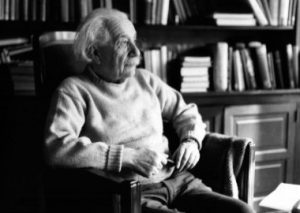 I have always been intrigued by Albert Einstein. Albert Einstein had an estimated IQ (Intelligence Quotient) of 160 to 190, although it was never really tested, so it could be higher. According to Mensa International, IQ is a score that identifies how far above or below someone is in comparison to others’ mental ability. Mensa is the largest and oldest high-IQ society in the world. It is a non-profit organization open to people who score at the 98th percentile or higher on a standardized, supervised IQ or other approved intelligence test.
I have always been intrigued by Albert Einstein. Albert Einstein had an estimated IQ (Intelligence Quotient) of 160 to 190, although it was never really tested, so it could be higher. According to Mensa International, IQ is a score that identifies how far above or below someone is in comparison to others’ mental ability. Mensa is the largest and oldest high-IQ society in the world. It is a non-profit organization open to people who score at the 98th percentile or higher on a standardized, supervised IQ or other approved intelligence test.
The term, IQ originated in 1912, and since then, IQ tests have been further developed to define standard deviations of someone’s logic and reasoning. Nevertheless, even with the tests, intelligence is not easy to measure. Many of those who are considered “the smartest people in the world,” such as Stephen Hawking and Albert Einstein, do not have extraordinarily high IQ scores in comparison with others. Still, the prowess they display in their everyday life and in the great achievements they make shows their intelligence in ways no test can effectively measure. I would think that this is a far greater measure of their intelligence. Some of the most intelligent people do not do well and do not like taking a test. Some even get very anxious when testing.

Of course, we have all heard of the famous Einstein equation E = MC² and have probably wondered what that was all about. It was in his 1905 paper, that Einstein proposed his famous equation: E = MC². That equation laid out a new understanding of “the matter/energy relationship where the energy of a body is equal to the mass of that body multiplied by the speed of light squared.” Now, if that doesn’t make sense to you…well, you are among the majority of people who feel the same way. First of all, tell me how fast if the speed of light squared. No, I can’t explain that either…but, Einstein knew. Einstein was awarded the Nobel Prize in Physics for his study of the photoelectric effect in 1921. Einstein (a Jewish man) immigrated to the United States during the outbreak of World War II, after being targeted by Hitler’s administration. In the United States, his work became crucial in the development of the atomic bomb later during the war.
While his great discoveries and scientific advancements were crucial to advancement on the world stage, they were not his only abilities. Einstein was outspoken, eloquent, and he had abilities that were far beyond the confines of the scientific community. He played the violin. He loved both the classic and popular literature of his time. He was funny, often without realizing it. He once told a conductor on the train he had boarded, when 
 asked for the ticket he had misplaced, that if he did not find his ticket…he would not know where to get off!! Eistein kept his mind clear for more important things, but not cluttering it with things that could be written down, such as the station when he was to disembark. He was also not snooty, and certainly not above making the occasional funny face. He was known for having clutter. He had too much on his mind to worry about neatness. All in all, Einstein was simply a real person, and his personality took in all that entailed. Today marks the 145th anniversary of this great man’s birth. I would have liked very much to know Albert Einstein.
asked for the ticket he had misplaced, that if he did not find his ticket…he would not know where to get off!! Eistein kept his mind clear for more important things, but not cluttering it with things that could be written down, such as the station when he was to disembark. He was also not snooty, and certainly not above making the occasional funny face. He was known for having clutter. He had too much on his mind to worry about neatness. All in all, Einstein was simply a real person, and his personality took in all that entailed. Today marks the 145th anniversary of this great man’s birth. I would have liked very much to know Albert Einstein.

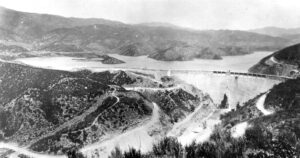 For as long as there have been dams to control water, there have been problems with those same dams. The Saint Francis dam in the San Francisquito Canyon in California was a concrete gravity dam, that was built between 1924 and 1926. A gravity dam is a dam constructed from concrete or stone masonry and designed to hold back water by using only the weight of the material and its resistance against the foundation. Gravity dams are designed so that each section of the dam is stable and independent of any other dam section…theoretically. The Saint Francis had only been standing two years, when it suddenly failed in 1928. The failure was catastrophic, and the flood that followed killed at least 431 people, in what is considered to have been one of the worst American civil engineering disasters of the 20th century and the third-greatest loss of life in California history. How could a dam that was only two years old fail so soon and so horribly.
For as long as there have been dams to control water, there have been problems with those same dams. The Saint Francis dam in the San Francisquito Canyon in California was a concrete gravity dam, that was built between 1924 and 1926. A gravity dam is a dam constructed from concrete or stone masonry and designed to hold back water by using only the weight of the material and its resistance against the foundation. Gravity dams are designed so that each section of the dam is stable and independent of any other dam section…theoretically. The Saint Francis had only been standing two years, when it suddenly failed in 1928. The failure was catastrophic, and the flood that followed killed at least 431 people, in what is considered to have been one of the worst American civil engineering disasters of the 20th century and the third-greatest loss of life in California history. How could a dam that was only two years old fail so soon and so horribly.
Not everyone was in favor of the dam, which as it turns out was only the second concrete dam to be designed and built by the Bureau of Water Works and Supply. The first was the nearly “dimensionally identical” Mulholland Dam. That dam construction was had begun one year earlier. The design of the Saint Francis Dam was actually an adaptation of the Mulholland Dam. The designer made modifications to suit the site, but can the same design work in two different locations. I suppose it could in the case of a building, but a dam would need to be designed with the specific soil type, terrain structure, and even earthquake fault lines in mind. The adaptations were supposed to take stress factors into consideration. Most of the design changes and computation figures of the possible stress factors for the Saint Francis Dam came from the work of the plans and formulas which had been used in the constructing of the Mulholland Dam. This work was done by the engineering department within the Bureau of Water Works and Supply.
The dam was built to serve the growing water needs of the city of Los Angeles. The plan was to create a large regulating and storage reservoir that was to be an important part of the Los Angeles Aqueduct. Unfortunately, the defective soil foundation of the area, and the design flaws of the dam led to the dam’s collapse just two 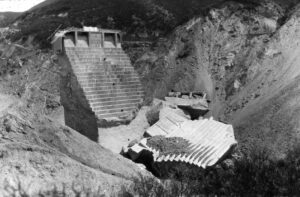
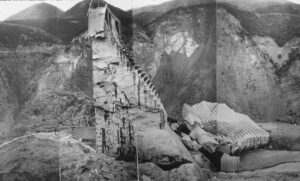 years after its completion. Two and a half minutes before midnight on March 12, 1928, the Saint Francis Dam catastrophically failed. Its failure caused the death of 431 people, and it ended the career of William Mulholland, the general manager and chief engineer of the Bureau of Water Works and Supply (now the Los Angeles Department of Water and Power).
years after its completion. Two and a half minutes before midnight on March 12, 1928, the Saint Francis Dam catastrophically failed. Its failure caused the death of 431 people, and it ended the career of William Mulholland, the general manager and chief engineer of the Bureau of Water Works and Supply (now the Los Angeles Department of Water and Power).
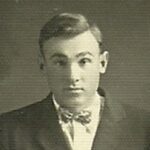
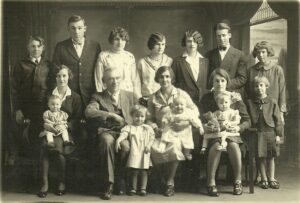 When my husband’s grandfather, Andy Schulenberg began his life, it was in perfect health. He was the oldest child of his parents Max and Julia Schulenberg. For the next fourteen years, siblings arrived on a regular basis, and Andy became the big brother to all of them. As with all big brothers, the younger nine kids looked up to their big brother….even the ones who were born after the incident that changed everything. When Andy was about 14 years old, he was out hunting, when something went terribly wrong. I don’t know exactly how, and maybe nobody does, but Andy was shot in the leg, and it was very serious.
When my husband’s grandfather, Andy Schulenberg began his life, it was in perfect health. He was the oldest child of his parents Max and Julia Schulenberg. For the next fourteen years, siblings arrived on a regular basis, and Andy became the big brother to all of them. As with all big brothers, the younger nine kids looked up to their big brother….even the ones who were born after the incident that changed everything. When Andy was about 14 years old, he was out hunting, when something went terribly wrong. I don’t know exactly how, and maybe nobody does, but Andy was shot in the leg, and it was very serious. 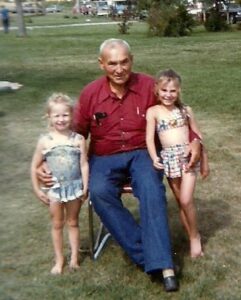
I can’t imagine how worried his parents were when they got the news. You never want to get bad news concerning your child, and this was some of the worst news there is. I’m sure that hearing that he would live was a huge relief, but the loss of his leg…just devastating. No one really knows how a person will be able to recuperate from such a loss. It affects not only the body, but the mind too. Our bodies aren’t designed to lose a limb. Can we survive that? Yes, but it will take time. For Andy, that meant a year in the hospital. He had to be fitted with a peg. They might have had a primitive form of a prosthetic leg, but probably not. So, for Andy, it would be a peg. Andy was a determined young man, and he refused to let this beat him. He was only 14 years old, and he had a life he wanted to live, yes, was determined to live.
So, he persevered and worked hard to recover and to learn how to maneuver. These days, a person who has suffered an amputation would see, not only a doctor, buy also a psychiatrist as well. It is a well-known fact, 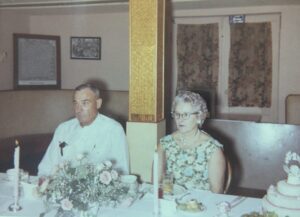
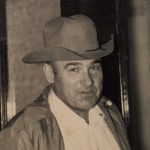 these days anyway, that such an injury affects the mind as much as the body. That was not as well known in those days, so Andy had to dig deep inside himself and pull out the fortitude and reshape his own life, and later became the sheriff of Rosebud County Montana. I think that the way he pulled himself up and got on with the business of life was just amazing. Today is the 118th anniversary of Grandpa Andy’s birth. Happy birthday in Heaven, Grandpa. We love and miss you very much.
these days anyway, that such an injury affects the mind as much as the body. That was not as well known in those days, so Andy had to dig deep inside himself and pull out the fortitude and reshape his own life, and later became the sheriff of Rosebud County Montana. I think that the way he pulled himself up and got on with the business of life was just amazing. Today is the 118th anniversary of Grandpa Andy’s birth. Happy birthday in Heaven, Grandpa. We love and miss you very much.
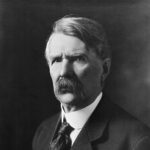
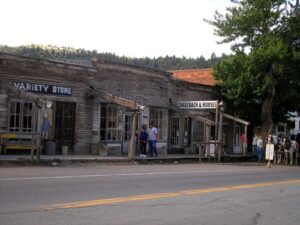 George Lane was a shoemaker by trade, back in the mid 1800s. He also had a birth defect, that earned him the nickname he hated all his life…Clubfoot. In an event that seems rather unusual to me, Lane was accused of being a member of Henry Plummer’s gang of “Innocents” and was hanged by Montana Vigilantes in January 1864. Lane was a small man, originally from Massachusetts. He later made his way to the west during the California Gold Rush. Like many people back then, he dreamed of becoming rich, and the Goldrush seemed as likely a way as any other. Things didn’t exactly go as planned, and he ended up working first on a farm in Yuba County, before making his way to Calaveras County, where he worked as a store clerk. Not quite the glamorous outcome he had in mind.
George Lane was a shoemaker by trade, back in the mid 1800s. He also had a birth defect, that earned him the nickname he hated all his life…Clubfoot. In an event that seems rather unusual to me, Lane was accused of being a member of Henry Plummer’s gang of “Innocents” and was hanged by Montana Vigilantes in January 1864. Lane was a small man, originally from Massachusetts. He later made his way to the west during the California Gold Rush. Like many people back then, he dreamed of becoming rich, and the Goldrush seemed as likely a way as any other. Things didn’t exactly go as planned, and he ended up working first on a farm in Yuba County, before making his way to Calaveras County, where he worked as a store clerk. Not quite the glamorous outcome he had in mind.
In 1860, gold was discovered in Washington Territory, and Lane once again followed the miners, with plans to “get rich quick” forming in his head. Again, Lane ran into trouble. This time in 1862 when a Lewiston, Idaho rancher accused him and another man of “running off horses.” That “crime” didn’t really seem as serious as the rancher supposed, but then I am not a lawman. Wanting to straighten things out, Lane turned himself into the Fort Lapwai commander, who assigned them to help with building construction. The following year, he and another man were accused of a similar crime, this time, driving a stolen horse herd toward the Snake River. The alleged horse thieves escaped, and by the fall of 1863, Lane had made his way to Virginia City, Montana. His situation and the oddly recurring events, make you wonder if he was as innocent as he claimed. He did, after all, run from the law his time. He soon went to work for Dance and Stuwart’s Store, mending harnesses and making and repairing boots. It would appear that he was at least trying to lead an honest life.
Lane began earning the respect of his employers. Nevertheless, he again came under suspicion when he rode to Bannack, Montana, to inform Henry Plummer of the George Ives trial taking place in Nevada City in December 1863. Though Plummer was absent at the time, Lane told Deputies Ray and Stinson of the growing vigilance movement in Virginia City. It would seem to me that when you are suspected of being a part of a criminal gang, that should be the furthest thing from your thoughts, if you want to look innocent anyway. Because of that trip, when the Vigilance Committee met the following month, Lane’s name immediately came up as a “spy” for the outlaw gang called The Innocents.
On January 14, 1864, Lane was arrested at Dance and Stuart’s store. When he asked why he was being arrested, the men informed him, “For being a road agent, thief, and an accessory to numerous robberies and murders on the highway.” Lane responded by saying, “If you hang me, you will hang an innocent man.” While his bosses liked and respected Lane, they assumed that the vigilantes had evidence against Lane, so they did not intervene. Not everyone thought Lane was guilty, but the Committee tried him anyway and found him guilty. He was sentenced to be hanged along with Frank Parish, Boone Helm, Haze Lyons, and Jack Gallager. Lane requested a minister be brought before he was executed which was scheduled to be the first execution. Then, as he was forced to stand on a box under the noose, Lane saw a friend. He yelled out, “Goodbye, old fellow; I’m gone.” He then leaped from the box without waiting for it to be removed…going out on his own terms. He and the others hanged that day were buried in Virginia City’s Boot Hill Cemetery. As punishment, none of the graves were given markers.
Placing no markers while maybe a “fitting punishment” can later pose a problem. Weh people began to ask who 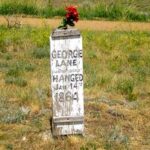
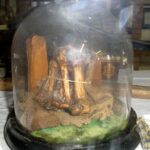 was in these graves, some 43 years later, it brought in question the deaths. In 1907, a former vigilante came forward, saying that he knew the order of the graves, and which one was Club Foot George’s. Their curiosity peaked now, the city soon dug up the grave that was allegedly Clubfoot George Lane’s. Everyone was surprised when he had been right. The deformed foot belonging to George Lane was indeed in the grave. The foot bones were then placed in a cabinet in the courthouse. Later, they were moved and placed on display in a glass jar at the Thompson Hickman Museum in Virginia City, Montana.
was in these graves, some 43 years later, it brought in question the deaths. In 1907, a former vigilante came forward, saying that he knew the order of the graves, and which one was Club Foot George’s. Their curiosity peaked now, the city soon dug up the grave that was allegedly Clubfoot George Lane’s. Everyone was surprised when he had been right. The deformed foot belonging to George Lane was indeed in the grave. The foot bones were then placed in a cabinet in the courthouse. Later, they were moved and placed on display in a glass jar at the Thompson Hickman Museum in Virginia City, Montana.

 When the Liedekerke-De Beaufort family left their previous home, Vêves Castle, during the French Revolution, they needed a new home. The castle that they would name Château Miranda was planned and designed in 1866 by the English architect Edward Milner. Unfortunately, Milner died in 1884 before the château was finished. I’m sure he would have loved to see his design completed. Construction was completed in 1907 after the clock tower was erected. The descendants of the Liedekerke-De Beauford family remained in occupation until World War II. During World War II, a small portion of the Battle of the Bulge took place on the property, and it was during that time that the château was taken over and occupied by German forces.
When the Liedekerke-De Beaufort family left their previous home, Vêves Castle, during the French Revolution, they needed a new home. The castle that they would name Château Miranda was planned and designed in 1866 by the English architect Edward Milner. Unfortunately, Milner died in 1884 before the château was finished. I’m sure he would have loved to see his design completed. Construction was completed in 1907 after the clock tower was erected. The descendants of the Liedekerke-De Beauford family remained in occupation until World War II. During World War II, a small portion of the Battle of the Bulge took place on the property, and it was during that time that the château was taken over and occupied by German forces.
The Liedekerke-De Beauford never moved back into Château Miranda. In 1950, it was renamed “Château de Noisy” when it was taken over by the National Railway Company of Belgium (NMBS/SNCB). During that time, and the reason for the strange name change, was that Château Miranda was converted into an orphanage and also a holiday camp for sickly children. Château Miranda lasted as a children’s camp until the late 1970s. Little is known about its occupation from the late 19702 to 1991, when it was abandoned and stood empty, because the cost to maintain it was too great, and a search for investors in the property failed. The municipality of Celles offered to take it over, but the family refused, and the enormous building lingered in a derelict state, slowly succumbing to decay and vandalism. At one point, parts of Château Miranda were heavily damaged in a fire, and many ceiling areas began collapsing. Despite this, it became a favorite site for exploration.
Finally, the fate of Château Miranda was decided, and demolition work began in 2016. This was mainly due to concern over the structural stability of the building. The demolition took approximately a year, beginning in 
 October 2016 with the removal of the roof. By October 2017, it was done…and, the Château Miranda had been completely demolished. The last part to be removed was the central tower. To me it is a terrible injustice for what was once so fine a castle. Sadly, not everyone sees the historic value in old buildings, and some would rather see these historic buildings restored, rather than have history destroyed.
October 2016 with the removal of the roof. By October 2017, it was done…and, the Château Miranda had been completely demolished. The last part to be removed was the central tower. To me it is a terrible injustice for what was once so fine a castle. Sadly, not everyone sees the historic value in old buildings, and some would rather see these historic buildings restored, rather than have history destroyed.

 My grandniece, Manuela Ortiz, has had a very exciting year. She and my grandnephew, James Renville are buying a house. The house belongs to his mom, Toni Chase currently, and it is the house where James spent much of his childhood, so it is really a cool thing for his to be buying this particular house. There are some renovations, repairs, and updates that they want to do, so they are working on those, and they aren’t in a big hurry to move in. They want it to be perfect for their move. It is a nice house, and we are all excited for
My grandniece, Manuela Ortiz, has had a very exciting year. She and my grandnephew, James Renville are buying a house. The house belongs to his mom, Toni Chase currently, and it is the house where James spent much of his childhood, so it is really a cool thing for his to be buying this particular house. There are some renovations, repairs, and updates that they want to do, so they are working on those, and they aren’t in a big hurry to move in. They want it to be perfect for their move. It is a nice house, and we are all excited for  them. James and Manuela met in 2019 and married in July of 2021. They have been living in an apartment, and now they are ready to have their own home.
them. James and Manuela met in 2019 and married in July of 2021. They have been living in an apartment, and now they are ready to have their own home.
Manuela has been working for the Wyoming Housing Network as a housing counselor. They have been so happy with her that she was recently given a promotion to the title of House Education Manager. We are so proud of her. Manuela immigrated to the United States from Colombia and had originally wanted to work in the United States to learn English. Her plan was to use English, as a way to be a more valuable asset to her employer back in Colombia, but God had other plans for her. Her Spanish and her mastery of English landed her the job she now has because she is able to be not only be a help in the housing market, but to cross a language barrier for people who really need that assistance. Of course, God also had the plan of a match made in Heaven for her and James…a match we are all very happy about.
This last summer, Manuela took James to Colombia to meet the new extended part of his family. It was his first 
 visit to Colombia, and his first time to meet any of her family, except for on Skype. As it turns out, James and Manuela’s mother, Consuelo share the same birthday. That made a June trip to Colombia perfect, because they held a birthday party for both of them while they were there. The trip was so much fun for Manuela and James. James loves to travel, and Manuela had a great time showing him all the sights in her homeland. I’m sure there will be many return trips in their future, and before we know it, James will be as fluent in Spanish as Manuela is in English. I’m so glad they got to make the trip. Today is Manuela’s birthday. Happy birthday Manuela!! Have a great day!! We love you!!
visit to Colombia, and his first time to meet any of her family, except for on Skype. As it turns out, James and Manuela’s mother, Consuelo share the same birthday. That made a June trip to Colombia perfect, because they held a birthday party for both of them while they were there. The trip was so much fun for Manuela and James. James loves to travel, and Manuela had a great time showing him all the sights in her homeland. I’m sure there will be many return trips in their future, and before we know it, James will be as fluent in Spanish as Manuela is in English. I’m so glad they got to make the trip. Today is Manuela’s birthday. Happy birthday Manuela!! Have a great day!! We love you!!

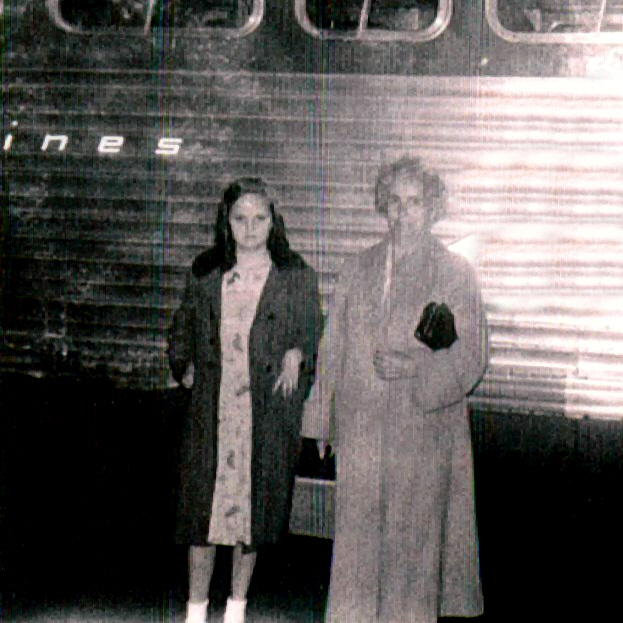 While visiting my Aunt Sandy Pattan during her stay at Elkhorn Valley Rehabilitation Hospital where she is recuperating from a recent surgery, we were talking about our favorite subject…the Byer-Pattan Family History. The subject turned to the many things her parents, my grandparents, George and Hattie Byer had seen come into being during their lifetimes. Grandpa was born on June 15, 1893, and Grandma was born on February 26, 1909. A sixteen-year age difference wasn’t that uncommon in those days, and many people to this day have a large age difference between husband and wife. Of course, the world when Grandma was born was already quite different than the world when Grandpa was born. The automobile was first invented…officially in 1889, but people really didn’t start owning them until about 1929, so by the time my grandparents were married in 1927, a few people might have owned their own car, but many still didn’t. For those, it was still the horse and buggy days.
While visiting my Aunt Sandy Pattan during her stay at Elkhorn Valley Rehabilitation Hospital where she is recuperating from a recent surgery, we were talking about our favorite subject…the Byer-Pattan Family History. The subject turned to the many things her parents, my grandparents, George and Hattie Byer had seen come into being during their lifetimes. Grandpa was born on June 15, 1893, and Grandma was born on February 26, 1909. A sixteen-year age difference wasn’t that uncommon in those days, and many people to this day have a large age difference between husband and wife. Of course, the world when Grandma was born was already quite different than the world when Grandpa was born. The automobile was first invented…officially in 1889, but people really didn’t start owning them until about 1929, so by the time my grandparents were married in 1927, a few people might have owned their own car, but many still didn’t. For those, it was still the horse and buggy days.
Planes were another thing that the most likely saw come into existence. While they existed at the time my grandmother was born, they did not during my grandfather’s early years. Nevertheless, like automobiles, planes were not something that was commonly in use for the average citizen. They were too expensive and so were only for the very rich or for military use. Most people who needed to travel long distances used the trains in those days, and some very likely still used the horse and buggy travel mode. Of course, truth be told, there 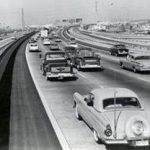
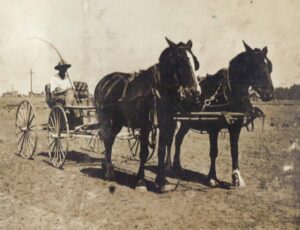 are still those who use a horse and buggy today. The Amish and even a few others, but the others are mostly for show, like parades, races, and such. Personally, my husband, Bob and I dearly love the trains. We ride one pretty much every year. I think trains are in my blood. My dad grew up riding them, because his dad worked as a carpenter for the Great Northers Railroad. Because of that, his kids got a free pass to ride…within reason, of course.
are still those who use a horse and buggy today. The Amish and even a few others, but the others are mostly for show, like parades, races, and such. Personally, my husband, Bob and I dearly love the trains. We ride one pretty much every year. I think trains are in my blood. My dad grew up riding them, because his dad worked as a carpenter for the Great Northers Railroad. Because of that, his kids got a free pass to ride…within reason, of course.
Televisions might have been “invented” in the late 1800s, but they were not common in homes until much later. In fact, in 1947 there were only a few thousand televisions in homes in the United States. I suppose that getting programming together could have had something to do with it, but many people thought it was an unnecessary evil, and maybe they had a point. Prior to that time, families would gather around the radio to hear the latest news…especially when it came to the important news of the wars.
Telephones were just as rare. Invented in 1869 by Alexander Graham Bell, although, it was truly a race between him and other competitors. Nevertheless, he was granted the patent. By 1920, about 35% of homes had phones. These days we couldn’t imagine running our lives without a phone, and who needs a home, we carry them in our purses, pockets, backpacks, and even on our wrist. If you don’t have access to your phone, it 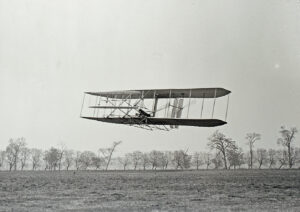
 is entirely your fault…either you forgot it or you let the battery die. Either way…your fault. Aunt Sandy and I agreed that there have also been a lot of changes in our eras, but maybe not quite as drastic as the ones our parents and grandparents saw. I’m quite sure there will be many more changes as time goes on. Space travel, for the common man being one. Wow!! Now, that’s something to think about!!
is entirely your fault…either you forgot it or you let the battery die. Either way…your fault. Aunt Sandy and I agreed that there have also been a lot of changes in our eras, but maybe not quite as drastic as the ones our parents and grandparents saw. I’m quite sure there will be many more changes as time goes on. Space travel, for the common man being one. Wow!! Now, that’s something to think about!!
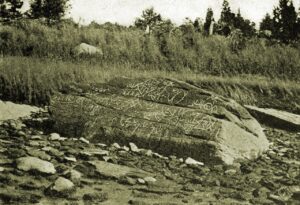
 The Dighton Rock is a 40-ton boulder that was found in the riverbed of the Taunton River at located Berkley, Massachusetts, over 300 years ago. The rock has puzzling petroglyphs on it that have apparently never been able to be deciphered. Dighton Rock is one of the greatest mysteries of Massachusetts. The boulder is slanted and has six sides. It is approximately 5′ high, 9½’ wide, and 11′ long. All of those 300 years, people have wondered about the lines, geometric shapes, drawings, and writing that appear on the rock and who created them. They wanted to figure it out. What did it mean? Who made those markings, so many years ago. No one really knows how long ago the marks were made, only about how long ago it was found.
The Dighton Rock is a 40-ton boulder that was found in the riverbed of the Taunton River at located Berkley, Massachusetts, over 300 years ago. The rock has puzzling petroglyphs on it that have apparently never been able to be deciphered. Dighton Rock is one of the greatest mysteries of Massachusetts. The boulder is slanted and has six sides. It is approximately 5′ high, 9½’ wide, and 11′ long. All of those 300 years, people have wondered about the lines, geometric shapes, drawings, and writing that appear on the rock and who created them. They wanted to figure it out. What did it mean? Who made those markings, so many years ago. No one really knows how long ago the marks were made, only about how long ago it was found.
The rock has been studied by many people over the years. In 1680, English colonist Reverend John Danforth drew a copy of the petroglyphs. That drawing has been preserved in the British Museum, but there are conflicts as to the accuracy of the drawing. Some say the markings aren’t exactly the same as the rock. In something as intricate as petroglyphs, accuracy would be of vital importance. Ten years later, in 1690 Reverend Cotton Mather described the rock in his book, The Wonderful Works of God Commemorated: “Among the other Curiosities of New England, one is that of a mighty Rock, on a perpendicular side whereof by a River, which at High Tide covers part of it, there are very deeply Engraved, no man alive knows How or When about half a score Lines, near Ten Foot Long, and a foot and half broad, filled with strange Characters: which would suggest as odd Thoughts about them that were here before us, as there are odd Shapes in that Elaborate Monument…”
One theory suggests that Indigenous peoples of North America…who were known to have inscribed petroglyphs in rocks (a schematic face on the Dighton Rock is similar to an Indian petroglyph in Eastern Vermont) made the markings. A second theory suggests that Ancient Phoenicians made them was proposed in 1783 by Ezra Stiles in his “Election Sermon” as the “descendants of the sons of Japheth.” Still another theory suggests that the Norse might have made them. That theory was proposed by Carl Christian Rafn in 1837, but it was rejected by archaeologists such as TD Kendrick and Kenneth Feder. Others suggested that the Portuguese may have made them. That was proposed in 1912 by Edmund B Delabarre, who (after seeing Portuguese writing) believed that they then used the rock for their own inscriptions. Delabarre wrote that “markings on the Dighton Rock suggest that Miguel Corte-Real reached New England. Delabarre stated that the markings were abbreviated Latin, and the message, translated into English, reads as follows: “I, Miguel Cortereal, 1511. In this place, by the will of God, I became a chief of the Indians.'” Of his findings, Douglas Hunter wrote in his book “Reconstructing the 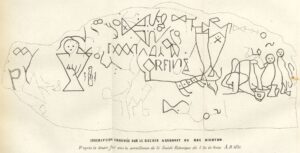
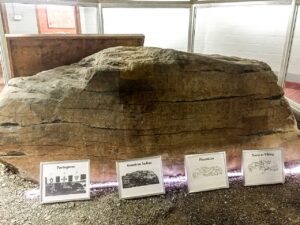 history of writing about Dighton Rock” provides copious evidence and analysis debunking the Corte-Real origin myth. Lastly, the Chinese have also been suggested as a possible source, proposed by Gavin Menzies in his 2002 book “1421: The Year China Discovered America.” I don’t think we’ll ever know who made them or what they mean.
history of writing about Dighton Rock” provides copious evidence and analysis debunking the Corte-Real origin myth. Lastly, the Chinese have also been suggested as a possible source, proposed by Gavin Menzies in his 2002 book “1421: The Year China Discovered America.” I don’t think we’ll ever know who made them or what they mean.

